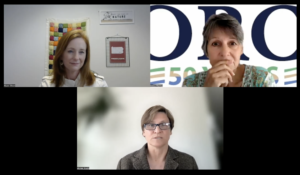Listening and Learning: Achieving Environmental Wins Through Convening

Denice Wardrop, Executive Director of the Chesapeake Research Consortium, moderated the webinar featuring two experts on collaborative efforts and environmental facilitation. Michele Drostin, Delmarva Land and Litter Collaborative (DLLC), and Allyson Gibson, Lancaster Clean Water Partners, shared their experiences building trust and forward movement in groups with varied goals and interests.
Takeaways from the webinar
Michele Drostin works with the DLLC at the intersection of a healthy ecosystem and chicken and grain farming on the Delmarva peninsula. The challenges facing these issues are multidimensional, so the solutions must cross boundaries and focus on consensus.
- “Elect the individual, not the organization”. It is important that members find value in the program and understand the mission and goal, to enhance the collaborative value and efforts.
- DLLC utilizes a consensus based structure for decision making, ensures a balanced membership and organization, values building process and relationships over specific products, and provides long term support. Strong, committed membership with high group cohesion is essential to limit turnover and create meaningful products through a collective identity and trust.
- DLLC’s litter matching app matches up people who have litter with people who need litter. Also connects to people who can transport and spread litter. This was brought about by listening to the needs of members.
- Trust is communicable, trust in DLLC members can then spread throughout their networks of trust. It is important to embrace the networks of members to spread wins and collaborative work.
Allyson Gibson works with Lancaster Clean Water Partners. Lancaster has been deemed an official “welcoming city”, best place to retire, and more but also has a significant amount of polluted streams. Multi-sector collaboration that reflects the diversity of the city is needed to advance clean water issues.
- Multi-sector collaboration solves not just an individual problem, but tries to solve issues involving a community’s systems. With 1,400 miles of streams impaired in Lancaster, this multi-sector collaboration is key to create a shared vision and mission.
- The Common Agenda LCWP created aimed to be simple and attainable. It focuses on 6 areas: the problem, the solution, the priorities, strategies, progress indicators, and shared values of all involved.
- Get the “who”, before the “what” or how”: you have to have the big vision thinkers at the table to catalyze efforts. Representation matters in decision making.
- Need to have a bias towards action- be a “do” tank rather than a “think” tank. You need to operate with a sense of urgency to get things done and gain success.
Resources for further action
How Collective Impact Funders Can Build Trust
How Funders of Collective Impact Initiatives Can Build Trust
